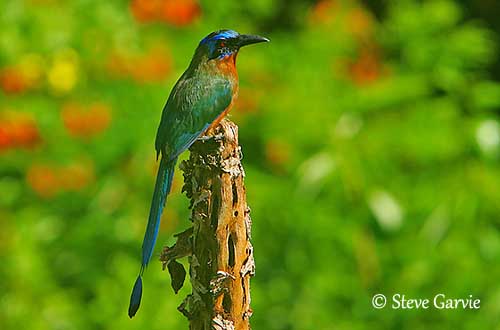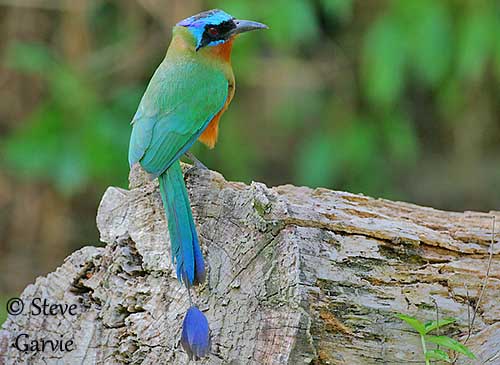
Fr: Motmot de Trinidad
Ang: Trinidad Motmot
All: Trinidadmotmot
Esp: Momoto de Trinidad
Ita: Motmot di Trinidad
Nd: Trinidadmotmot
Sd: trinidadmotmot
Photographer:
Steve Garvie
RAINBIRDER Photo galleries & Flickr Rainbirder
Text by Nicole Bouglouan
Sources :
HANDBOOK OF THE BIRDS OF THE WORLD Vol 6 by Josep del Hoyo-Andrew Elliott-Jordi Sargatal - Lynx Edicions, 2001 - ISBN: 848733430X
The Online Guide to the Animals of Trinidad and Tobago
Momotus bahamensis (Trinidad Motmot) - Author: Lauren T. Campbell
Neotropical Birds – Cornell Lab of Ornithology
Celebrating our endemic birds – Trinidad and Tobago NEWSDAY
Trinidad Motmot
Momotus bahamensis
Coraciiformes Order – Momotidae Family
INTRODUCTION :
The Trinidad Motmot was formerly a subspecies of the Amazonian Motmot (Momotus momota) from Amazon region.
It is now a full species, endemic to Trinidad and Tobago where it is confined and geographically isolated from other Momotidae. It frequents the interior of lowland evergreen forest on Trinidad, whereas on Tobago, it occurs mainly in areas with large trees. It is arboreal, often active in the early morning and the late afternoon.
The Trinidad Motmot nests in burrow and breeds during the rainy season. The male often offers flowers, leaves, twigs or grass to the female during courtship.
DESCRIPTION OF THE BIRD:
Biometrics:
Length: 46 cm
Weight: 99-114 g
The Trinidad Motmot adult has beautiful head pattern with a stout black bill, and a long racquet tail.
The upperparts including back and wings are green. The uppertail is mostly green at base, and blue towards the tip. The central pair of rectrices is much longer than other tail feathers and has racquet tips.
The underparts are rufous-brown with some isolated blue and black feathers on the upper breast.

On the head, the crown is black, bordered by a broad azure-blue stripe extending from the bill to the rear crown, forming an incomplete diadem. Lores and mask are black and ear-coverts are blue. We can see a narrow, blue malar stripe below the black mask which tapers in a point on the sides of the head. The nape is washed buff.
The black bill is serrated, well-adapted to the feeding behaviour. The rictal bristles are well-developed. The eyes are deep red. Legs and feet are grey.
Male and female are similar.
The juvenile resembles adult, but it lacks the blue and black upper breast feathers. The mask is mostly sooty-black. The long racquet tail is absent.
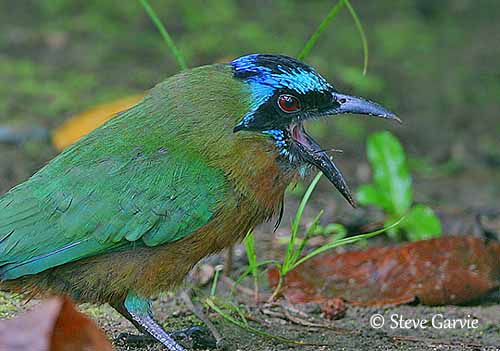
RANGE:
The Trinidad Motmot is confined to Trinidad and Tobago.
HABITAT:
The Trinidad Motmot is found in the interior of the lowland evergreen forest on Trinidad. On Tobago, it is mainly found in cacao plantations, sandy beaches and open habitats including pastures with large trees.
CALLS AND SONGS: SOUNDS BY XENO-CANTO
The Trinidad Motmot sometimes mimics calls of other bird species. But usually, the male produces low sounds described as “coot-coot” or “whoo-whoo-hoot” while in pair or alone near the burrow.
While approaching the nest, the adult’s voice becomes lower and expresses a slight anxiety “whoo-whoo-o-o-o-o”. When the parents are feeding the chicks and return to the burrow, they produce ruffling sounds with their feathers and utter soft calls before entering the nest. The alarm call is “wac-wac” and other dry notes.
While foraging in small family groups, the birds give a loud clucking noise to communicate “kla-kla-kla-kla” with variable intensity. This sound can last 2-5 minutes in length.
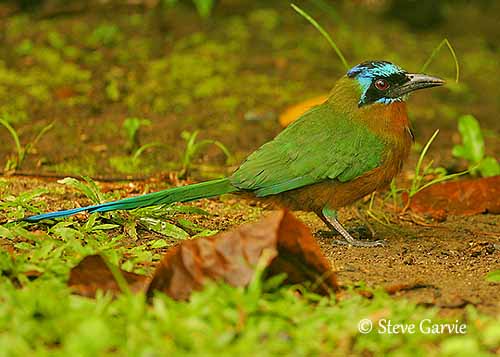
BEHAVIOUR IN THE WILD:
The Trinidad Motmot feeds on invertebrates found in the leaf litter on the ground. It follows the swarms of army ants or small birds which help it to locate spiders, insects and various invertebrates. It may occasionally catch small reptiles and young birds, and it also takes molluscs and earthworms.
It hunts from low perch and swoops down onto the detected prey. The animal is beaten on a tree branch before to be swallowed whole.
On Tobago, it feeds mainly on fruits in wet and dry seasons, and it takes dung beetles and cicadas during the rainy season.
The Trinidad Motmot uses its long racquet tail for visual communication. When excited, it moves its tail back and forth. This behaviour often allows locating the bird among the foliage.
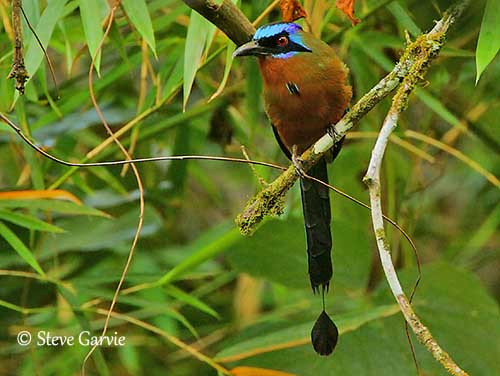
During the breeding season, the Trinidad Motmot becomes more vocal in order to attract a female, but also during pair-bonding and courtship displays. It sings frequently just before dawn and at dusk.
These vocalizations are used to establish the territory. The males advertise by a low-frequency “hoot-hoot”, sometimes longer, up to height notes.
The male often offers some leaves, twigs, flowers or grass to the female during courtship. They live in pairs instead of flocks, and they are monogamous. They remain together for one year.
During aggressive disputes or in territorial defence, they produce hoarse, dry coughing sounds. Long chattering and swinging tail (or penduluming) are performed when the birds are excited.
The Trinidad Motmot is probably resident, with some short movements related to food and behaviour.
With its short, rounded wings, the bird performs a rapid flight, but rarely over long distances.
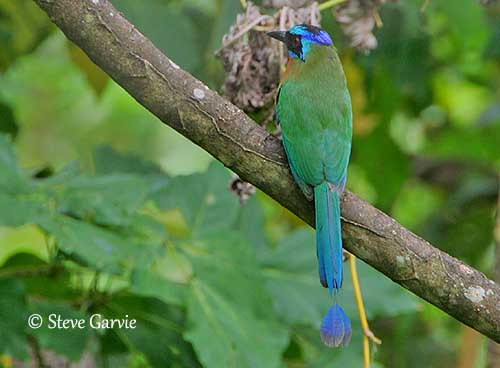
REPRODUCTION OF THIS SPECIES:
The breeding season takes place in spring, with the laying in April-May on Trinidad, and between March and July on Tobago.
The Trinidad Motmot nests in burrow excavated in earth bank by both adults working in alternating stints. The burrow is usually straight, but bends of 90% are not uncommon. The length varies from 3 to 5 metres. The entrance is always well-concealed behind tree roots or trunk, or any other objet. A new burrow is dug for each breeding season during the autumn for the next spring. That explains why the mates remain together during one year.
The female lays 3 white eggs and both adults share the incubation, the female usually at night. Incubation and fledging periods are unknown, but they are probably similar to those of M. momota, with an incubation period of 3 weeks and the young fledge about one month after hatching. The young are able to forage alone after leaving the burrow.
PROTECTION / THREATS / STATUS:
The Trinidad Motmot has small range. The species is much commoner on Tobago where it is a tourist’s attraction, whereas it is considered shy and uncommon on Trinidad.
The population size is unknown, but it is suspected to be stable.
The Trinidad Motmot is currently evaluated as Least Concern.
